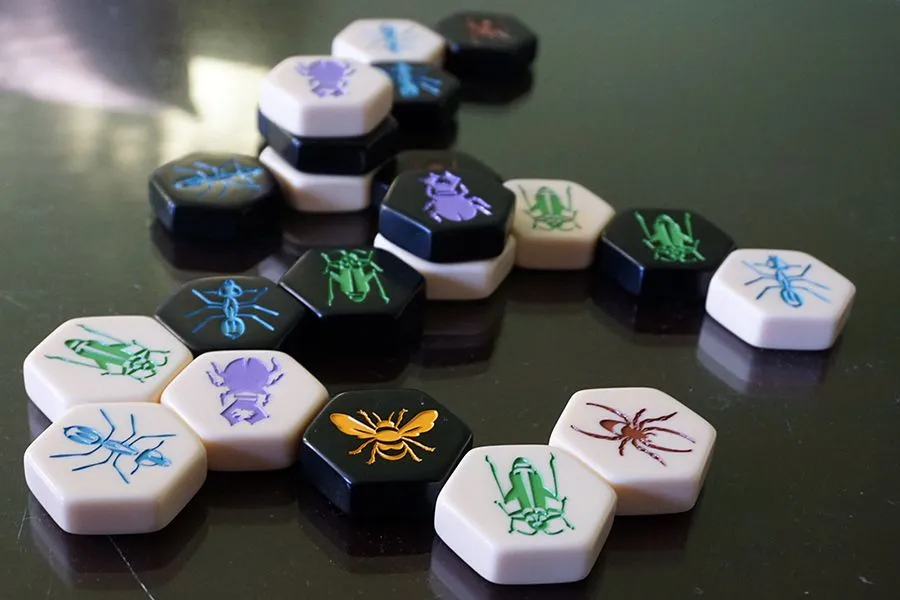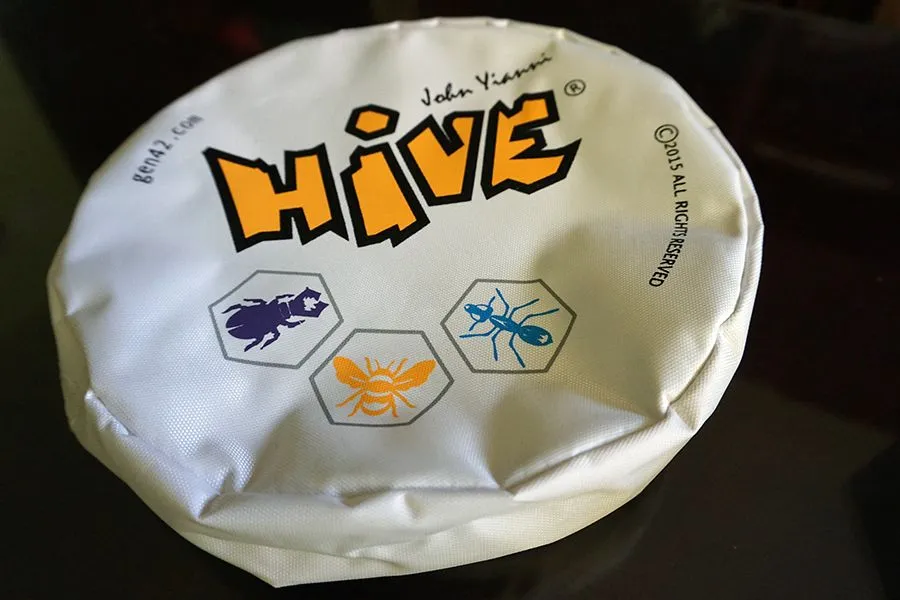Greetings, fellow master planners and executors!
Greetings, fellow Hive creatures!
Coming in with a recent update on a blast from the past. I remember playing the Hive game when it was young. Sorry, it was always cool. What I mean is, on no occasion was it not cool.
And recently, when I saw it at the game store that a couple of friends run back in Sofia, I bought a copy because...
Hive.
No, not only that. Because it's a well designed game that can be played at an early age and also at masters' level. It's like Chess in that regard.
But with bugs (in the insect sense) and no initial board required.

The tiles you see above all fit into that small pouch you see below.

Well, minus the rule book which becomes obsolete quite quickly as you learn the few things you need to know. Same as in Chess. You don't see many Chess players running around with rule books under their arms, now, do you? I only saw a couple of those during the whole day yesterday.
So...how do you play the basic edition...
You have two players taking turns placing or moving a tile they own.
On the first turn, the one who goes first places a tile anywhere on the table/ surface you play on. Then the other player places a tile touching one of its six sides to it. From then on, each player can either move a tile according to the guidelines I shall in a minute describe, or place a new tile from their reserves, except...
You have to place your Queen up until your fourth turn;
You cannot move tiles until your Queen has been placed;
The tiles you place must touch any your tiles but they cannot initially touch on the side of a tile of your opponent. That does not apply only in the above-mentioned case of placing the second tile in the game.
Each player has 11 pieces initially, and it's up to you how much you keep in reserve (not yet placed on the game area, A.K.A. The Hive) and how much you move your tiles already placed, before using the tiles from your reserve.
The Hive's integrity must be kept at all times...
meaning you cannot move a piece if that would separate the remaining tiles in two or more groups. They should all stay connected through at least one tile. That rule turns out to be pretty important and pretty hard to plan for.
The Game Objective...
Is to have your opponent's Queen surrounded on all sides. It doesn't matter if the surrounding pieces are yours, or their own, or a combination of both (most usually).
The Game Pieces...
A Queen — moves one hexagonal space at a time by sliding around the edge of another tile it touches. It cannot move into spaces it cannot freely slide into. The edges of the hexagonal tiles could create situations where a space is too narrow (the width of only a single tile side) for a whole hexagonal tile to move through.
You Have one Queen tile only.
A Beetle — moves the same as the Queen but it also can climb upon another piece, temporarily blocking its movement and also making certain that the tile space counts as the color that the beetle is. You can place a tile next to one of your opponent's if your beetle is on top of it, effectively changing its color. A beetle can also climb down from any piece, filling an empty space, or it could crawl on top of other pieces starting from the one beneath, one hexagonal space at a time. Unless there's another beetle on top of it, blocking its movement.
Yes, you can "beetle" the Beetle.
The Beetle cannot slide through narrow spaces but it could take two turn to climb on top of one of the pieces blocking the entrance, and then climb down into the closed-of hexagonal space.
You have two Beetles.
A Spider — can only slide exactly three spaces, touching the side of other tiles all along its movement. It cannot backtrack and go back to a space it occupied during a previous phase (if you count them one-two-three, then "two" cannot go back where "one" was and "three" cannot go back where "two" was) on the same turn. You cannot halt until you move all those three spaces.
You have two Spiders. They are creepy, of course.
A Grasshopper — hops from its current position above a line of other tiles and ends its movement at the first empty hexagonal space. It can move across long distances if there are lots of pieces lined-up there in a straight fashion. The Hive's integrity must still be kept. (E.g., on the first picture, only one of the Grasshoppers can be moved without breaking the integrity of the game. The white Grasshopper tile on the left, above the White Ant tile. It can either jump across that Ant tile, or across the Black Ant, the Black Grasshopper, the Black Beetle that's upon a White tile, And the other White Grasshopper.)
You have three Grasshoppers.
An Ant — cans slide as the Spider does, but it can go any distance — from one space only, to all around the Hive. Very dangerous. They seem to come out of nowhere.
You have three Ants.
It's that simple!
And it's also that complex.
So...
Good Luck And Have Fun!
Yours,
Manol